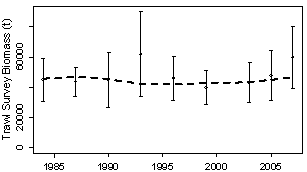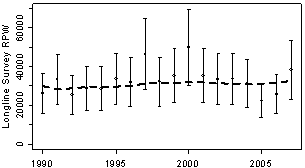

MESA: Rougheye Rockfish Stock Status
|
NMFS trawl survey estimates, with 95% confidence intervals (CIs) and assessment model fit (dashed line). |
| |
|
AFSC longline survey relative population weights (RPW), with 95% CIs and assessment model fit (dashed line). |
Rougheye and blackspotted rockfish are managed together. Estimates of population trends are generated in an age-structure model adaptable to several rockfish species and implemented in AD Model Builder software. Data sets include total catch, fishery size compositions, trawl and longline survey biomass estimates (graphs to right), trawl survey age compositions, and longline survey size compositions.
The main difference between the rougheye model and other rockfish models is the addition of the AFSC sablefish longline survey index (bottom graph). The trawl survey is not typically capable of sampling the deeper depths and high relief habitat of rougheye rockfish, while the longline survey can sample a large variety of habitats. One drawback, however, is that juvenile fish are not susceptible to longline gear; therefore, the longline survey does not provide much information on recruitment. The trawl survey may be limited in sampling particular habitats, but does capture juveniles. Using both longline and trawl survey estimates in the models should alleviate concerns of undersampling adult habitat or juvenile fish. Estimates of biomass are relatively steady over time, with female spawning biomass well above target levels. In general, recruitment is highly variable, particularly in the most recent years where very little information exists on this part of the population. Projected biomass is stable and the Gulf of Alaska rougheye rockfish stock is believed to be healthy and not overfished.
Contact:
Kalei Shotwell
Auke Bay Laboratories
Alaska Fisheries Science Center, NOAA Fisheries
Ted Stevens Marine Research Institute
17109 Pt Lena Loop Rd
Juneau AK 99801
Kalei.Shotwell@noaa.gov
|


